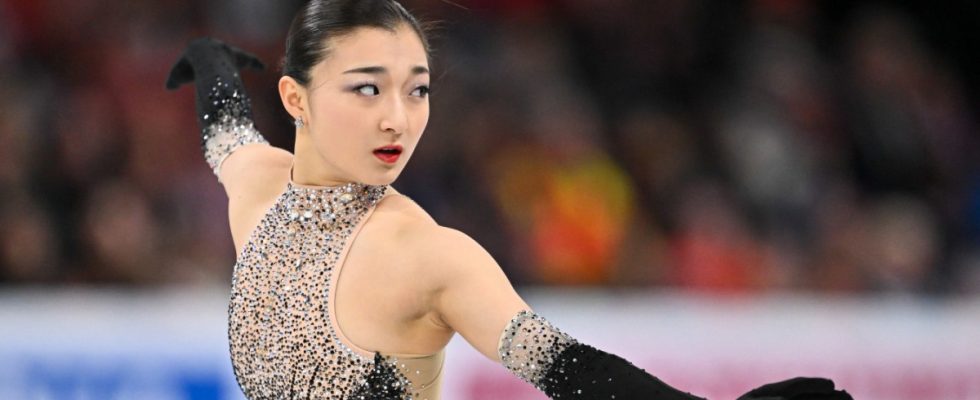When three-time figure skating world champion Kaori Sakamoto stepped off the podium in Montreal, it became clear that she also had a fabulous speed skater in her. On the lap of honor, wrapped in the Japanese flag, she discovered that colleague Isabeau Levito, 17, had no such cloth on hand. Sakamoto raced off, skidded across the ice on sharp edges, borrowed a stars-and-stripes flag from the other side of the stands and carefully placed it around the US silver medalist’s shoulder. Thinking about the needs of your worst rivals in the moment of triumph doesn’t happen every day in the frosty high-performance industry.
Kaori Sakamoto, 23, from Kobe was in every respect the outstanding soloist of this championship. Peggy Fleming from the USA last managed to win three World Cup titles in a row more than half a century ago (1966 to 1968). Sakamoto has mastered the art of making the complicated look easy through dance, her programs flow like the ink of calligraphy, every landing on a runner is the beginning of a new, sweeping line. She began her free routine “Feeling Good”, with which she improved from fourth place to first place, with a double axel, followed by seven triple jumps including a combination, all less high than mostly far: less hopping than flying.
Sakamoto’s Olympic freestyle had a programmatic title: “I am a Woman”
The world champion did not have a quadruple jump in her program, nor did the other 23 athletes in the free skate; The German champion Kristina Isaev from Oberstdorf did not make it to the finals due to an unfortunate mistake in the short free program. Since the runners from Russia, the specialists in these feats of strength on runners, were excluded from international competitions because of the war of aggression against Ukraine, the quadruple rotations in the air, which lightweights in particular can master, have also disappeared. At the weekend in Canada, the art of figure skating was celebrated rather than athletics in the women’s competition, but this could change in the future. Second place Isabeau Levito, for example, danced a ballet with six triple jumps to the music of “The White Crow”, the film about the life of Rudolf Nureyev.
In the case of Kaori Sakamoto, her international breakthrough can be dated to the 2022 Winter Olympics, when she won the bronze medal. However, her impressive freestyle that evening was lost in the tumult surrounding 15-year-old Russian Kamila Valiyeva, who, after learning of her doping findings, stumbled across the ice crying, beaten and nervously shattered. The mature, elegant performance by Sakamoto, then 21, with the programmatic title “I am a Woman” to a song by Imany already seemed like a commentary in Beijing on the events surrounding the ice skating prodigies. Two months later in Montpellier, in the absence of the Russian athletes, she became world champion for the first time.
The world association ISU then decided to gradually increase the minimum age for the senior class in figure skating to 17 by the 2026 Olympics. Which doesn’t mean that the ice skating children’s drill is already over: In Moscow, the team led by twelve-year-old Margarita Basiliuk recently won a jumping tournament; she showed a combination of quadruple Salchow, Euler, quadruple Salchow. A world premiere, commented the trade magazine pirouette, because to date “no one, not even a man” has mastered it. Sakamoto is aware that she would hardly be able to compete against the best Russians at the moment, as she said in Montreal: she will have to increase the level of her technical elements in order to compete at the 2026 Olympics.
The Lord of Jumps: World champion Ilia Malinin from the USA presents the audience with, among other things, a quadruple axel.
(Photo: MInas Panagiotakis/Getty)
At the World Championships, the quadruple jumps were purely a male domain. And the athletes, especially 19-year-old Ilia Malinin from Fairfax/Virginia, have actually continued to increase the spiral of extreme difficulty. The two-time US champion, trained primarily by his parents, presented the enthusiastic audience with six clean quadruple jumps – including the quadruple axel, the most difficult element because it requires four and a half revolutions in the air. Malinin was rewarded by the judges with a record free skate score and World Championship gold; he had an enormous lead over Yuma Kagiyama from Japan. The European champion, Adam Siao Him Fa from France, only ranked 19th after a completely failed short program, made a phenomenal jump to third place. At the end of the freestyle he even conjured up an illegal backflip on the ice. He took the points deduction for this. What kind of capers can we expect next season? “Wait and see!” said Malinin and smiled meaningfully.

